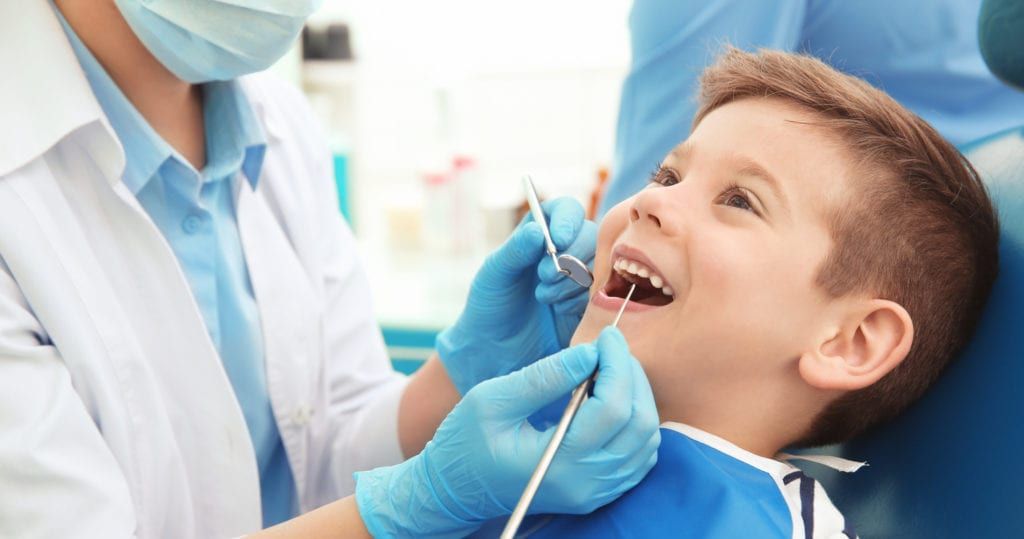Childrens Dentist Williamsburg VA
Baby’s First Teeth:
Usually, the front four teeth begin to appear when a baby is between 6 to 12 months. Some babies experience sore or tender gums while teething. Gently rubbing the child’s gums with a clean finger or wet gauze can be soothing. A clean teething ring may also help. Contrary to common belief, fever is not normal while teething. If a fever is present, call your physician.
Most children have a full set of 20 primary (baby) teeth by age 3. Primary teeth are as important as permanent teeth are for chewing, speaking, and appearance. They also help “hold” space in the jaws for the permanent teeth.
Tooth Decay:
Tooth decay can appear as soon as the teeth appear. Decay in primary teeth can damage erupting permanent teeth. When sugar and starch from food or drinks combine with plaque (a film of bacteria), an acid is produced that attacks tooth enamel. This can eventually result in a cavity. Therefore, limiting snacks and sweet drinks will reduce the possibility of cavities. Select foods from the five food groups for a balanced diet when a between-meal snack is needed. This will help avoid unneeded appointments with your child’s dentist.
Baby Bottle Tooth Decay:
One serious form of decay among children is baby bottle tooth decay. This condition is caused by frequent and long exposures of an infant’s teeth to liquids that contain sugar. Among these liquids are milk (including breast milk), formula, fruit juice, and other sweetened drinks.
Putting a baby to bed for a nap or at night with a bottle other than water can cause serious and rapid tooth decay. If you must give the baby a bottle as a comforter at bedtime, it should contain only water.
After each feeding, wipe the baby’s gums and teeth with a damp wash cloth or gauze pad to remove plaque.
Thumb Sucking:
Sucking is a natural reflex and infants and young children may use thumbs, fingers, pacifiers and other objects on which to suck. Thumb sucking that persists beyond the eruption of the permanent teeth can cause problems with the proper growth of the mouth and tooth alignment. Children should cease thumb sucking by the time their permanent front teeth are ready to erupt. Children usually stop between the ages of 2 and 4. Pacifiers are no substitute for thumb sucking. They can affect the teeth essentially the same way as sucking fingers and thumbs.
Diet:
A good diet is essential for a child’s growth and development. Like the rest of the body, the teeth, bones, and soft tissues of the mouth need a well-balanced diet. Various factors can determine how foods affect a child’s teeth. The more frequently a child snacks, the greater the chance for tooth decay. How long food remains in the mouth also plays a role. For example, hard candy and breath mints stay in the mouth a long time, causing longer acid attacks on the tooth enamel.
Brushing & Flossing:
Brushing and flossing help remove harmful plaque bacteria. A child-size brush with soft, rounded bristles is recommended. Check your child’s toothbrush often and replace it when it is worn. Begin daily brushing as soon as the first tooth erupts. A pea-size amount of toothpaste can be used after the child is old enough not to swallow it. By age 4 or 5 until about age 7, children should be able to brush their own teeth with supervision.
Flossing, however, is a more difficult skill to master. As soon as the spaces close between the teeth, begin flossing the child’s teeth until they can do it alone.
Sealing Out Decay:
A sealant is a clear plastic material that is applied to the chewing surfaces of the permanent back teeth (premolars and molars), where decay occurs most often. Pits and fissures are depressions and grooves in the chewing surfaces of the back teeth. They are difficult to keep clean because toothbrush bristles cannot reach into them. The sealant forms a thin covering that keeps out plaque and food and decreases the risk of tooth decay. As long as the sealant remains intact, the tooth surface will be protected from decay. Sealants usually last several years before a reapplication is needed.
Childrens Dentist Visits:
Regular dental visits are crucial to maintaining a healthy smile. Take your child to see the dentist by his or her first birthday. Although this may seem early, the dentist can explain how the child’s teeth should be cleaned at home, how diet and eating habits affect teeth, and examine for tooth decay. The first cleaning appointment can be scheduled between the ages of 2 and 3.
Malocclusion:
Malocclusion, or bad bite, is a condition in which the teeth are crooked, out of alignment, or the jaws don’t meet properly. This condition may become particularly noticeable between the ages of 6 and 12, when the permanent teeth are coming in. This “bad bite” may be inherited or result from events in the child’s development. The starting age, the duration of orthodontic treatment, the type of appliances used, the outcome of the treatment, and the cost of treatment depends upon the nature and severity of the malocclusion. Visit your childrens dentist for a treatment regimen.
Sports Mouth Guards:
When a child begins to participate in recreational activities and organized sports, injuries can occur. Mouth guards are an important piece of protective face gear for children and adults. A custom mouth guard made in the dental office or dental lab is dramatically more protective than one purchased from a store. The custom mouth guard helps prevent broken teeth, injuries to the lips and face, jaw fractures and concussions. These mouth guards are durable, stay in place well, are easy to breathe with and can even be made for the child wearing braces.


